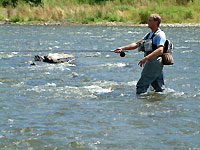 365 lakes and two great rivers, the Shannon and the Erne, make County Cavan an angler's paradise. The area is particularly known for coarse angling. Perhaps inspired by the area's crystalline waters, craftsmen continue to produce fine quality Irish crystal at Cavan Crystal.
365 lakes and two great rivers, the Shannon and the Erne, make County Cavan an angler's paradise. The area is particularly known for coarse angling. Perhaps inspired by the area's crystalline waters, craftsmen continue to produce fine quality Irish crystal at Cavan Crystal.
The north-west of the county is mountainous. The Cuilcagh Mountains rise here. Follow the Cavan Way up the uplands to the 'Shannon Pot' the mysterious source of the river Shannon taking in ancient tombs and megaliths along the way. The mountains are also a natural habitat for many bird species including the elusive peregrine falcon. Golf and horse riding are popular in the green valleys of County Cavan.
Book a self-catering holiday cottage, house or pine lodge as a base for touring Ireland - holiday cottages in Ireland
There are plenty of thriving towns and villages in County Cavan to entertain and enthrall tourists; Arvagh, Bailieborough, Ballinagh, Ballyconnell, Ballyhaise, Ballyjamesduff , Bawnboy, Belturbet, Blacklion, Butlersbridge, Cavan, Cootehill, Dowra, Fartha. Glangevlin, Killeshandra, Kingscourt, Mullagh, Rivory, Shercock, Stradone, Swanlinbar, and Virginia. Discover good restaurants, friendly Irish pubs, culture and history.
History has not left this land unmarked and signs of an ancient past can be seen in monuments like the Killycluggin Stone, an iron-age stone edifice, or the ancient burial site of Cohaw Court Cairn. Cavan was also badly affected by the Irish potato famine. The Cavan County Museum, in Ballyjamesduff, is located in an atmospheric building, the former Poor Clares Convent. The museum tells the tale of Cavan through the ages. Finally, living history can be experienced at the Lifeforce Mill. This Victorian watermill is still in use and visitors are guided round this fascinated piece of rural history.
Interestingly, Cavan borders northern Ireland, and is one of 3 counties in the Irish Republic that are part of Ulster Province.
Related Irish pages:
-
Self-catering cottages for angling or fishing holidays in Ireland,
-
Self-catering cottages in Northern Ireland


